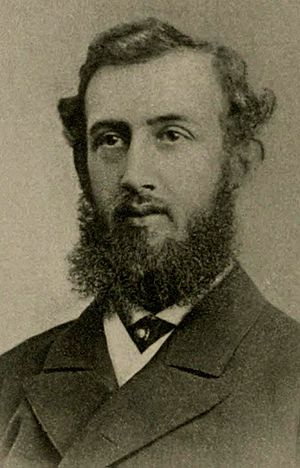William Winwood Reade facts for kids
William Winwood Reade (born December 26, 1838 – died April 24, 1875) was a British historian, explorer, writer, and thinker. He is best known for his book The Martyrdom of Man (1872), which was a history of the world, and his novel The Outcast (1875). These books were even included in a famous collection called the Thinker's Library. Reade also wrote one novel using a secret name, Francesco Abati.
Contents
Who Was William Winwood Reade?
His Early Life and Education
William Winwood Reade was born in Perthshire, Scotland, in 1838. He came from a rich family that owned a lot of land. He went to Oxford University but didn't finish his studies there. Even though he wrote two novels, he wasn't very successful as a novelist at first. Because of this, Reade decided to try something new: exploring different parts of the world.
His Exciting Journeys to Africa
When he was 25, Reade used his own money and got help from the Royal Geographical Society. He set off for Africa, arriving in Cape Town by a paddle steamer in 1862. He spent several months watching gorillas and traveling through Angola.
After his trip, Reade went home and published his first travel book, Savage Africa. Some people thought the writing style was a bit young. However, the book was important because it explored different cultures and people. It also talked about how Africa might be divided between Britain and France in the future.
In 1868, Reade got support from Andrew Swanzy, a trader from the Gold Coast in London. This allowed him to travel to West Africa. He tried to get permission to enter the Ashanti Empire but couldn't. So, Reade traveled north from Freetown to explore areas beyond Falaba, the capital of Solimana.
The local King Seedwa held him captive in Falaba for three months. It was a very difficult time for Reade. A legend says that King Seedwa gave Reade four tough tasks every day, and Reade completed all of them with great skill.
Even though Reade explored some new places, his discoveries didn't get much attention from geographers. This was mainly because he didn't make accurate measurements of his journey. He had left his sextant (a tool for measuring positions) and other instruments behind. However, his experiences in West Africa were still useful for science. He wrote letters to Charles Darwin, a famous scientist. Darwin later used information from Reade for his important book, The Descent of Man (1871).
Soon after returning, Reade published The African Sketch-Book (1873). This book described his travels and also suggested that Britain should get more involved in West Africa. Reade went back to Africa in 1873 to report on the Ashanti War. Sadly, he died not long after. He was buried in Ipsden churchyard, Oxfordshire, near his family's home.
The Martyrdom Of Man (1872): A Big History Book
The Martyrdom of Man (1872) is a very long book that tells the history of the Western world. Its main idea is summed up as "From Nebula to Nation," meaning from the very beginning of the universe to the creation of countries. It looks at history from a non-religious point of view.
The book is divided into four main parts, each about 150 pages long:
- War: This part talks about how people's bodies were controlled or imprisoned.
- Religion: This section discusses how people's minds were controlled by beliefs.
- Liberty: This is the most like a regular history of European politics and ideas.
- Intellect: This part explores the ideas about how the universe began and developed, which is common in "universal histories."
Why The Martyrdom of Man Was Important
Many people who believed in non-religious ideas saw The Martyrdom of Man as a kind of "substitute bible." In this book, Reade tried to show how Western civilization developed, using ideas similar to those in natural science. He used it to promote ideas of political freedom and social Darwinism (the idea that only the strongest survive and thrive in society).
The last part of the book caused a lot of debate. Reade openly criticized Christian beliefs, and several magazines spoke out against the book. In 1872, William Gladstone, who was the British Prime Minister, called The Martyrdom of Man one of several "irreligious works."
Reade was not an atheist (someone who doesn't believe in God), even though some critics said he was. He believed there was a Creator, but that this Creator was too great for humans to fully understand or pray to. He was a social Darwinist who thought that "survival of the fittest" was important. He believed that war, slavery, and religion were once necessary, but that in the future, only science could help humanity progress. Still, the book also showed the huge amount of suffering and struggle involved in the idea of evolution.
The Outcast (1875): A Story of Rejection
Reade's other non-religious book, The Outcast (1875), is a short novel. It tells the story of a young man who is rejected by his religious father and then deals with the sadness of his wife's death.
Other Books by William Winwood Reade
- (1859). Charlotte and Myra: A Puzzle in Six Bits.
- (1860). Liberty Hall, Oxon. (A Novel)
- (1861). The Veil of Isis or Mysteries of the Druids.
- The Druids.
- Druidism in Rustic Folklore.
- Druidism in the Emblems of Freemasonry.
- Druidism in the Ceremonies of the Church Of Rome.
- Rites And Ceremonies Of The Druids.
- Vestiges Of Druidism.
- The Destruction Of The Druids.
- Priestesses Of The Druids – Pamphlet.
- (1864). Savage Africa.
- (1865). See-Saw: A Novel (Written under the pseudonym Francesco Abati).
- (1872). The Martyrdom of Man.
- (1873). African Sketch-Book.
- (1874). The Story of the Ashantee Campaign.
- (1875). The Outcast.
- (1972). Religion in History.


